Rolex GMT vs Tudor GMT: A Luxury Watch Face-Off
In the world of luxury timepieces, few complications capture the essence of global travel like the GMT function. The Rolex GMT-Master II and Tudor Black Bay GMT stand as paragons of this feature, each offering a unique blend of style and functionality. This comprehensive comparison aims to guide you through the nuances of these horological marvels, helping you choose the perfect dual-time companion. From their inception during the golden age of air travel to their modern incarnations, these watches have evolved to meet the needs of globetrotters and watch enthusiasts alike.
Brand Heritage and Positioning
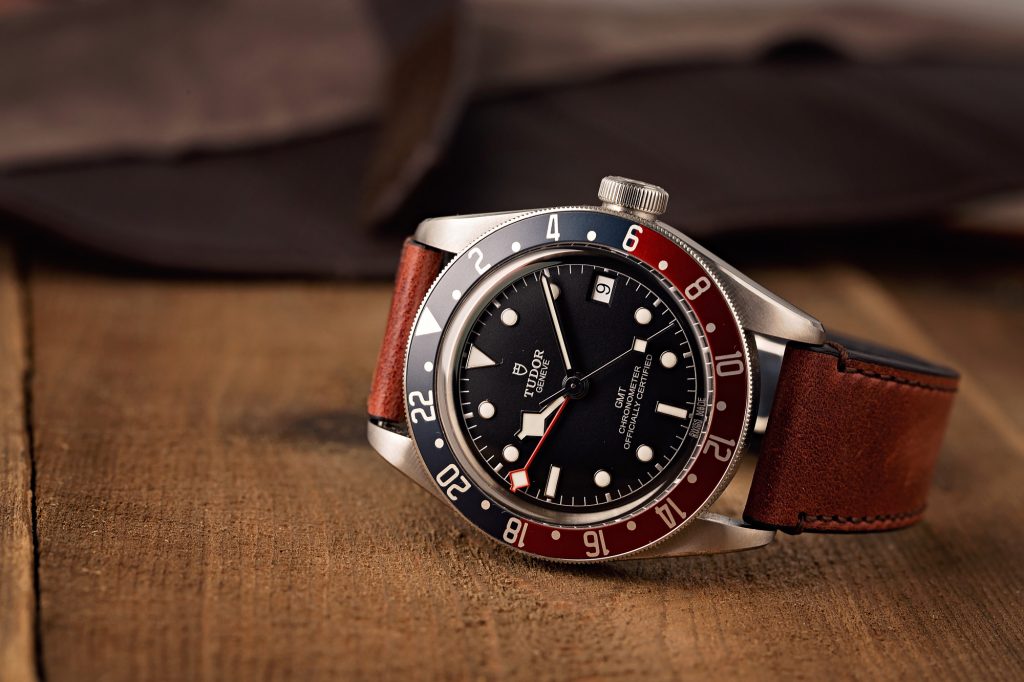
The story of Rolex and Tudor’s GMT watches is deeply intertwined with the history of aviation and the rise of international travel. Both brands, while sharing a common origin, have carved distinct niches in the luxury watch market. Understanding their heritage and positioning is crucial to appreciating the significance of their GMT offerings.
Rolex GMT: A Legacy of Precision and Luxury
Rolex introduced the GMT-Master in the 1950s, a time when intercontinental travel was becoming increasingly common. Developed in collaboration with Pan American Airways, the GMT-Master was designed to meet the specific needs of pilots navigating long-haul flights across multiple time zones. The iconic two-tone bezel, allowing for easy reading of a second-time zone, quickly became a hallmark of the model.
Over the decades, the Rolex GMT-Master and its successor, the GMT-Master II, have maintained their position as the gold standard for luxury travel watches. Each iteration has brought refinements in design and technology, from the introduction of more durable materials to the development of the independently adjustable hour hand in the GMT-Master II. Today, the Rolex GMT stands not just as a functional tool for travelers, but as a symbol of horological excellence and globetrotting sophistication
Tudor GMT: A Blend of Tradition and Innovation
Tudor, often referred to as Rolex’s younger sibling, shares a rich heritage with the crown but has forged its own distinct identity in the watch world. Founded by Rolex creator Hans Wilsdorf, Tudor was conceived as a more accessible brand that still embodied the quality and reliability associated with Rolex. This shared DNA is evident in many of Tudor’s designs and technical features.
The introduction of the Tudor Black Bay GMT in 2018 marked a significant milestone for the brand. It brought Tudor into direct competition with its parent company in the GMT market, offering a compelling alternative that combines vintage-inspired aesthetics with modern watchmaking technology. Positioned as a more affordable yet still high-quality option, the Black Bay GMT has quickly gained popularity among watch enthusiasts and casual wearers alike, proving that Tudor can hold its own in the competitive world of luxury timepieces.
Model Variations and Reference Number
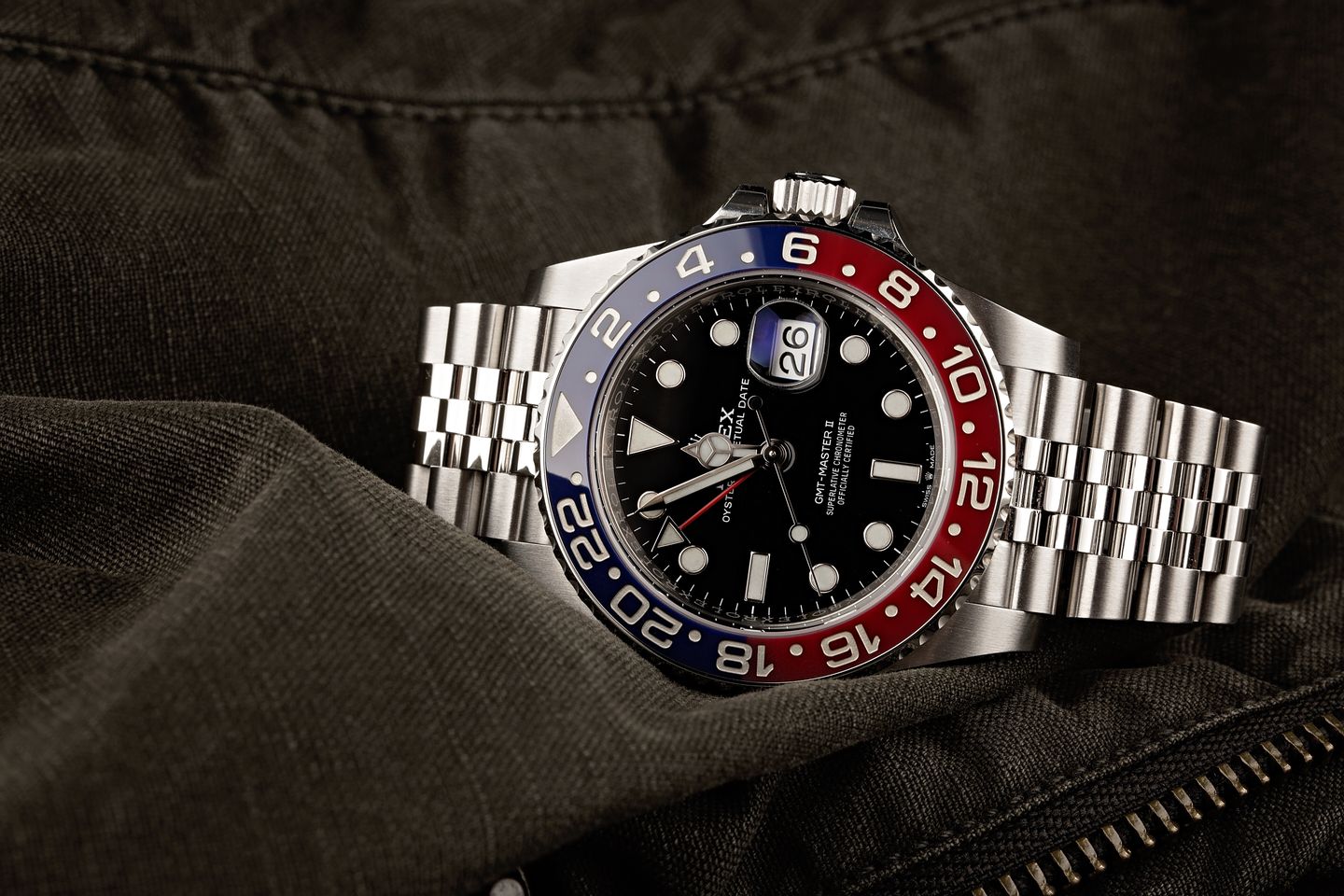
The Rolex GMT and Tudor GMT lines each offer a range of models, catering to different tastes and preferences. Understanding these variations is key to appreciating the nuances between the two brands and finding the perfect watch for your needs. Let’s explore the most notable models from both Rolex and Tudor, their unique features, and how they compare to each other.
Rolex GMT-Master and GMT-Master II
The Rolex GMT-Master line has seen significant evolution since its introduction. The Rolex 1675, produced from 1959 to 1980, is a classic that set the standard for the line. Its iconic "Pepsi" bezel and robust design laid the foundation for future models. The enduring popularity of the ref. 1675 among collectors speaks volumes about its timeless appeal and historical significance in the world of horology.
In 2007, Rolex introduced the ref. 116710LN, marking a significant upgrade in the line. This model featured a ceramic bezel, offering enhanced durability and scratch resistance. The all-black design provided a modern, stealthy alternative to the traditional two-tone bezel, appealing to those seeking a more understated look. The incorporation of Rolex’s proprietary Cerachrom material in the bezel was a game-changer, ensuring that the watch would maintain its appearance for years to come.
More recent additions to the GMT-Master II line have continued to push boundaries. The ref. 126710BLRO, unveiled in 2018, brought back the beloved “Pepsi” bezel in Cerachrom, combining nostalgia with cutting-edge materials. Meanwhile, the ref. 126711CHNR, known as the "Rolex Root Beer," showcases the brand’s mastery of materials with its two-tone steel and Everose gold construction. These models exemplify how Rolex continues to innovate within the GMT line, offering new color combinations and luxury options while maintaining the core functionality that made the watch famous.
Tudor GMT Models
Tudor’s entry into the GMT market is primarily represented by the Black Bay GMT ref. M79830RB. Introduced in 2018, this model quickly became a fan favorite, offering Tudor's take on the classic "Pepsi" bezel design. It successfully combines the vintage-inspired aesthetics of the Black Bay line with the practicality of a GMT function, creating a watch that appeals to both traditionalists and modern watch enthusiasts.
While Tudor hasn’t released as many variations as Rolex, they have introduced subtle changes and limited editions that cater to different preferences. These include variations in bracelet options, such as the steel bracelet, leather strap, and fabric strap. Each option gives the watch a distinctly different character, allowing wearers to transition from sporty to more casual or dressy looks with ease.
Across its editions, the Black Bay GMT maintains consistent features that have become hallmarks of the model. These include the distinctive snowflake hands, a matte black dial, and an aluminum bezel. This consistency has helped establish a strong identity for the Tudor GMT, making it instantly recognizable to watch enthusiasts and setting it apart from its Rolex counterpart.
Comparative Analysis
When comparing popular models from both brands, several key differences emerge. Rolex GMT models generally offer more variety in terms of materials and color combinations. The use of Cerachrom for bezels gives Rolex watches enhanced scratch resistance and color longevity. Tudor, on the other hand, opts for aluminum bezels, which some enthusiasts prefer for their vintage feel and potential to develop character over time.
The most sought-after models often include the Rolex Pepsi and Rolex Batman variations, prized for their iconic status and limited availability at authorized dealers. These models frequently command premiums on the secondary market, reflecting their desirability among collectors. Tudor’s Black Bay GMT has gained popularity for offering a similar aesthetic at a more accessible price point, making it an attractive option for those seeking the GMT functionality without the higher price tag of a Rolex.
Ultimately, the choice between Rolex and Tudor GMT models often comes down to personal preferences in design, budget considerations, and whether one favors modern luxury or vintage-inspired aesthetics. Both brands offer exceptional quality and heritage, ensuring that whichever model you choose, you’ll be wearing a piece of horological history on your wrist.
Design and Aesthetics
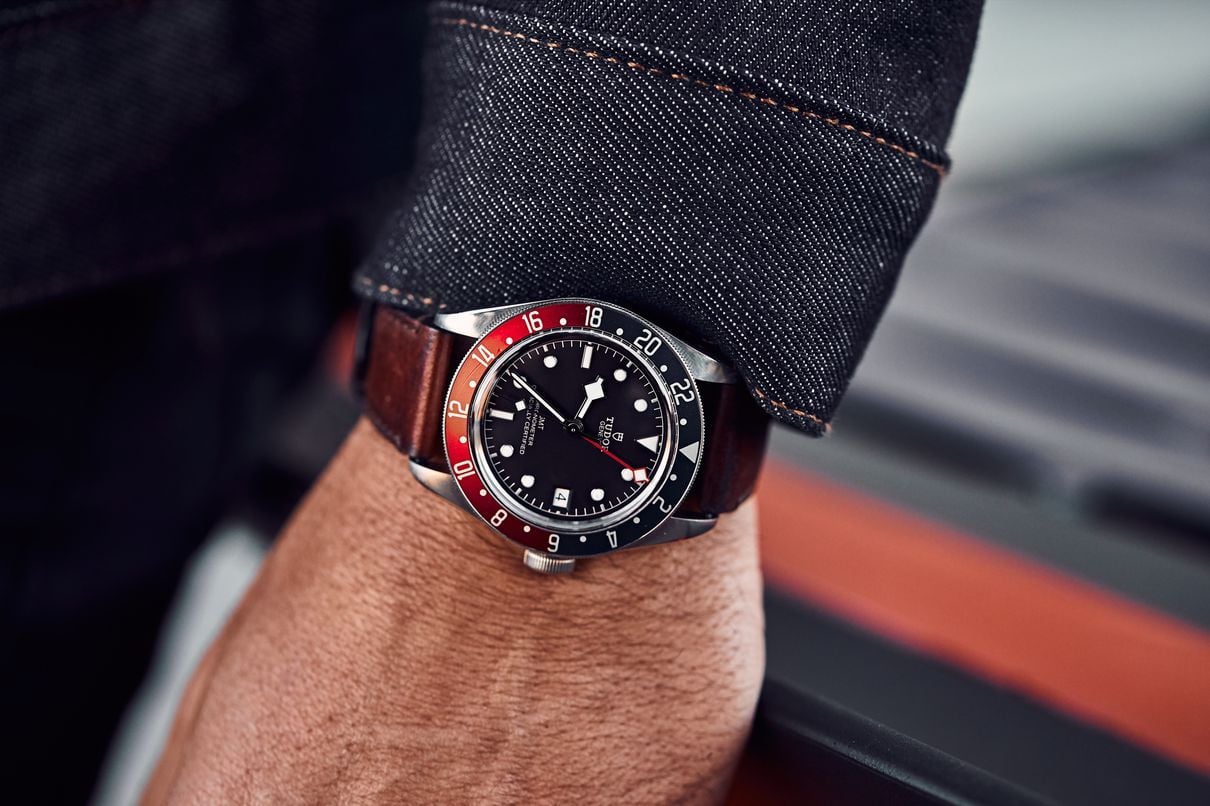
The visual appeal of a watch is often what first catches our eye, and both Rolex and Tudor have crafted their GMT models with distinctive design languages. While sharing some common DNA, each brand has put its unique spin on the GMT watch concept, resulting in timepieces that are both functional and visually striking. Let's delve into the design elements that set these watches apart.
Rolex GMT: Timeless Elegance Meets Modern Luxury
The Rolex GMT-Master II is a study in refined luxury, blending classic elements with contemporary materials. The case design is quintessentially Rolex, featuring the brand’s signature Oyster case that has become synonymous with robustness and water resistance. Typically measuring 40mm in diameter, it strikes a balance between presence on the wrist and wearability for a wide range of wrist sizes.
The dial of the Rolex GMT is a masterclass in legibility and sophistication. Available in various colors, including classic black and striking blue, it features applied hour markers filled with Rolex’s proprietary Chromalight luminescent material. The iconic Mercedes hour hand and the distinctive GMT hand in a contrasting color ensure that all four time zones are easily readable at a glance.
Perhaps the most recognizable feature of the Rolex GMT is its bi-color bezel. Crafted from Cerachrom, Rolex's high-tech ceramic material, it's virtually scratchproof and fade-resistant. The two-tone design not only serves a functional purpose for distinguishing day and night hours but also adds a pop of color that has become iconic in the watch world.
The bracelet options for the Rolex GMT-Master II include the robust Oyster bracelet and the more elaborate Jubilee bracelet. Both feature Rolex’s Easylink extension system, allowing for quick adjustments of up to 5mm - perfect for those hot days when your wrist tends to expand.
Tudor GMT: Vintage Charm with Modern Reliability
Tudor’s approach to the GMT aesthetic leans heavily on vintage-inspired elements, creating a watch that feels both familiar and fresh. The case of the Black Bay GMT, while similar in size to its Rolex counterpart at 41mm, has a distinct shape with more pronounced angles, giving it a tool watch vibe that harkens back to the golden age of travel.
The dial of the Tudor GMT is a study in understated elegance. The matte black face provides a perfect backdrop for the signature snowflake hands and applied hour markers. This design choice not only pays homage to Tudor’s diving watch heritage but also ensures excellent legibility in various lighting conditions.
Tudor’s take on the GMT bezel is both familiar and unique. While it maintains the iconic “Pepsi” color scheme, the use of aluminum instead of ceramic gives it a slightly more muted appearance. This choice of material not only keeps costs down but also appeals to enthusiasts who appreciate the way aluminum bezels can develop a unique patina over time.
When it comes to bracelet options, Tudor offers versatility. The riveted steel bracelet is a nod to vintage Tudor watches, complete with faux rivets that add visual interest. For those seeking a more casual look, Tudor also offers leather and fabric strap options, allowing wearers to easily change the character of the watch.
Side-by-Side Comparison
Placing these two watches side by side reveals a fascinating contrast in design philosophies. The Rolex GMT-Master II exudes modern luxury, with its high-tech materials and refined finishing. Every element, from the case to the bracelet, speaks to Rolex’s position at the pinnacle of luxury watchmaking.
The Tudor Black Bay GMT, on the other hand, charms with its vintage-inspired aesthetics. It manages to capture the essence of a tool watch while incorporating modern manufacturing techniques and materials. The result is a watch that feels both nostalgic and contemporary.
These design differences have a significant impact on wearability. The Rolex, with its more polished look, transitions seamlessly from the boardroom to a dinner party. The Tudor, with its more rugged appearance, feels equally at home in casual settings and outdoor adventures. Ultimately, the choice between the two often comes down to personal style preferences and the intended use of the watch.
Technical Specifications and Features
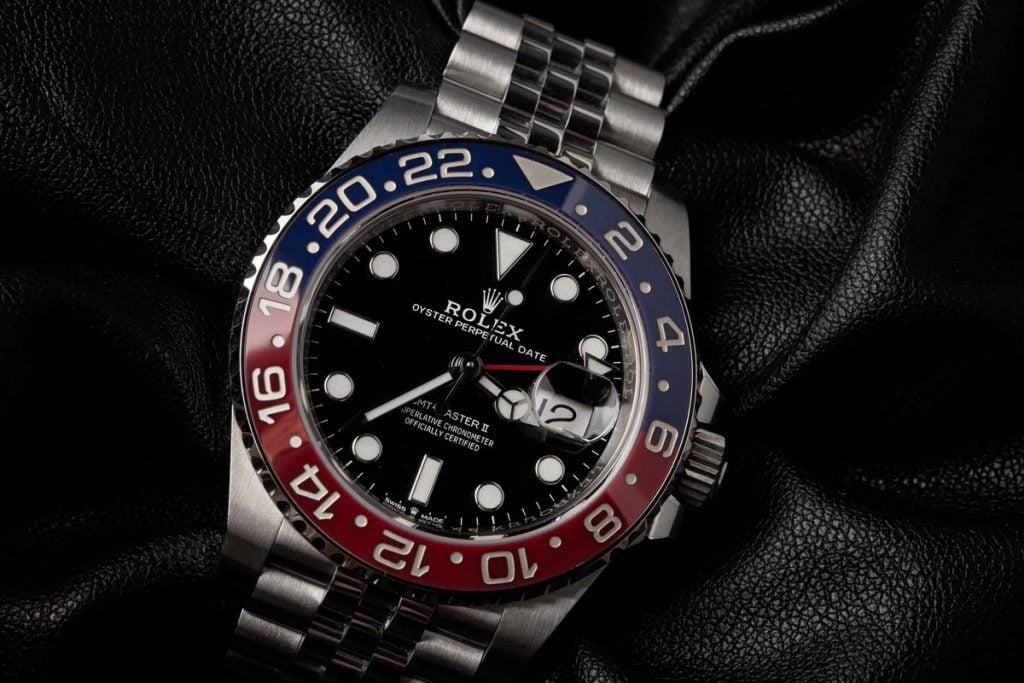
While aesthetics play a crucial role in watch selection, the heart of any timepiece lies in its technical prowess. Both Rolex and Tudor have equipped their GMT models with impressive movements and features that cater to the needs of modern travelers and watch enthusiasts. Let’s dive into the technical aspects that set these watches apart.
Movement Comparison
At the core of the Rolex GMT-Master II beats the Caliber 3285, a movement that showcases Rolex’s horological expertise. This self-winding mechanical movement boasts several of Rolex’s innovative technologies, including the Chronergy escapement and a blue Parachrom hairspring. These features contribute to the movement’s high energy efficiency and resistance to magnetic fields, ensuring reliable timekeeping in various conditions.
The Tudor Black Bay GMT is powered by the Caliber MT5652, a movement that demonstrates Tudor’s commitment to in-house manufacturing. This COSC-certified chronometer movement features a silicon balance spring, known for its resistance to magnetic fields and temperature variations. While it may not have all the refinements of the Rolex caliber, it’s a robust and reliable movement that punches above its weight class.
Both movements offer impressive power reserves, with the Rolex Caliber 3285 providing approximately 70 hours and the Tudor MT5652 offering about 70 hours as well. This means both watches can be taken off for a weekend and still be running when you return to them on Monday morning. In terms of accuracy, both movements meet chronometer standards, with the Rolex typically achieving slightly tighter tolerances in real-world use.
GMT Functionality
The GMT function is the star of the show in both these watches, but they approach it slightly differently. The Rolex GMT-Master II features an independent hour hand, allowing for easy adjustment when changing time zones. This means you can adjust the local time without affecting the minutes, seconds, or GMT hand – a feature particularly useful for frequent travelers
Tudor’s approach with the Black Bay GMT links the GMT hand to the main hour hand. While this means adjusting time zones requires a bit more attention, it also simplifies the movement construction, contributing to the watch’s more accessible price point. In practice, both systems allow for tracking three time zones (two on the dial, one on the bezel), with the Rolex offering slightly more convenience in adjustment.
Setting and operating the GMT function on both watches is relatively straightforward, though the Rolex’s independent hour hand does give it an edge in user experience, especially for those frequently crossing time zones. The Tudor, while requiring a bit more attention during setting, offers a satisfying mechanical feel that many enthusiasts appreciate.
Water Resistance and Durability
Rolex’s Oyster case, a hallmark of the brand since the 1920s, provides the GMT-Master II with water resistance up to 100 meters (330 feet). This robust construction, coupled with the Triplock crown system, ensures that the watch can handle not just splashes but also recreational swimming and snorkeling.
The Tudor Black Bay GMT matches the Rolex in water resistance, also offering 200 meters of water resistance. This is impressive for a GMT watch and speaks to Tudor’s roots in dive watch manufacturing. Both watches feature screw-down crowns and solid case backs, contributing to their overall durability and water resistance.
In terms of everyday wear and tear, both watches are built to last. The Rolex’s use of 904L stainless steel (which they call Oystersteel) and ceramic bezel gives it a slight edge in scratch resistance. However, the Tudor’s use of 316L stainless steel and aluminum bezel is still highly durable and may even be preferred by those who appreciate the way these materials age over time.
Other Notable Features
Rolex equips the GMT-Master II with several additional features that enhance its functionality and prestige. The date function, magnified by the iconic Cyclops lens, is a Rolex trademark that improves readability. The Chromalight display on the dial and hands provides excellent luminescence, ensuring legibility in low-light conditions.
Tudor’s Black Bay GMT, while more restrained in its approach, doesn’t skimp on practical features. The snowflake hands, filled with Swiss Super-LumiNova, offer exceptional luminescence. The date function, while not magnified, is cleanly integrated into the dial design. Tudor’s choice of matte dial finish also contributes to excellent legibility in various lighting conditions.
Both watches offer hacking seconds (the ability to stop the seconds hand when setting the time), allowing for precise time-setting. This feature, combined with their respective chronometer certifications, ensures that both the Rolex and Tudor GMTs can serve as reliable timekeeping tools for even the most discerning users.
Price and Value Proposition

When considering a luxury timepiece, understanding the price point and long-term value is crucial. Both Rolex and Tudor offer compelling options in the GMT market, but their positioning and value propositions differ significantly. Let’s explore the financial aspects of these horological marvels.
Rolex GMT-Master II: The Premium Choice
The Rolex GMT-Master II commands a premium price, reflecting its status as a luxury icon. Retail prices for stainless steel models typically start around $10,000, with precious metal versions reaching significantly higher. However, the reality of Rolex ownership often involves waitlists and potential premiums in the secondary market due to high demand and limited supply.
Despite the high initial investment, Rolex GMT models have historically shown strong value retention and even appreciation. Popular references like the “Pepsi” and “Batman” often trade above retail in the secondary market. This combination of desirability and scarcity has made the GMT-Master II not just a timepiece, but a tangible asset for many collectors.
The question of whether a Rolex GMT is "worth it" extends beyond mere financials. Owners invest in the brand’s heritage, the watch’s build quality, and the prestige associated with wearing a Rolex. For many, the joy of owning a horological icon justifies the premium, especially when considering the potential for long-term value retention.
Tudor Black Bay GMT: Accessible Luxury
Tudor positions the Black Bay GMT as a more accessible entry into the world of luxury GMT watches. With a retail price typically around $4,000, it offers a significant value proposition for those seeking a high-quality Swiss GMT watch without the five-figure investment of its Rolex counterpart.
While Tudor watches generally don’t appreciate in value like Rolex, they have shown impressive stability in the secondary market. The Black Bay GMT, in particular, has maintained strong resale values, often trading close to its retail price. This stability, combined with Tudor’s growing reputation, makes it an attractive option for both enthusiasts and first-time luxury watch buyers.
Tudor’s value proposition extends beyond price. Buyers get a watch with a respected pedigree, in-house movement, and versatile design at a more approachable price point. For many, the Tudor offers the perfect balance of quality, brand recognition, and affordability in the luxury GMT watch market.
Cost vs. Features: A Balancing Act
When comparing the Rolex GMT-Master II and the Tudor Black Bay GMT, it’s essential to consider what you’re getting for your money. Both watches offer GMT functionality, robust build quality, and respected brand names. The Rolex, however, brings additional prestige, more advanced materials (like the Cerachrom bezel), and finer movement finishing.
The premium for the Rolex can be justified by its brand cachet, potentially stronger investment value, and some technical advantages. However, the Tudor offers remarkable value, providing many similar features and functionality at less than half the price of the Rolex.
Ultimately, the decision comes down to personal priorities. If owning the pinnacle of luxury watch brands and potentially seeing your watch as an investment is important, the Rolex may be worth the premium. If you're seeking excellent quality and similar functionality at a more accessible price point, the Tudor presents a compelling alternative.
Target Audience and Wearability
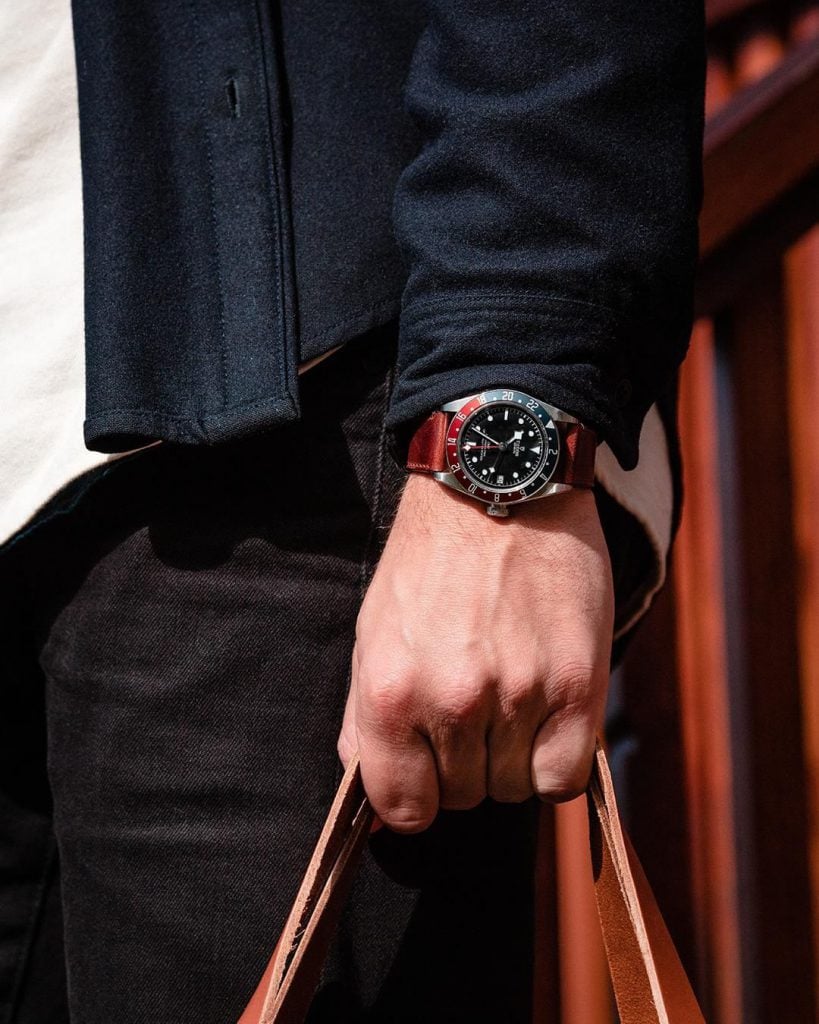
Understanding who these watches are designed for and how they fit into various lifestyles is crucial in making the right choice. Both the Rolex GMT-Master II and Tudor Black Bay GMT cater to specific audiences while offering versatility in wear. Let’s explore who might be drawn to each watch and how they fare in different settings.
Who Should Choose Rolex GMT?
The Rolex GMT-Master II appeals to a diverse but discerning audience. Luxury watch collectors and enthusiasts often see it as a must-have piece, representing the pinnacle of the GMT watch category. The history of Rolex GMT-Master II and its association with aviation makes it particularly attractive to those who appreciate the horological heritage.
The GMT-Master II also finds favor among successful professionals and business travelers. Its ability to track multiple time zones with ease, combined with its prestigious brand image, makes it an ideal companion for the global jet setter. The watch seamlessly transitions from boardroom to business class lounge, its refined aesthetics complementing both formal attire and smart casual wear.
Rolex’s reputation for quality and value retention also attracts those who view their timepieces as investments. While we always recommend buying a watch primarily for enjoyment, the GMT-Master II's track record for holding and often increasing in value adds an appealing financial dimension for some buyers.
Who Should Choose Tudor GMT?
The Tudor Black Bay GMT caters to a slightly different, though overlapping, audience. It’s particularly appealing to watch enthusiasts who appreciate fine timepieces but may not be ready or willing to invest in a Rolex. Its more accessible price point makes it attractive to younger professionals or those new to luxury watches.
Tudor’s vintage-inspired design and robust build quality resonate strongly with fans of tool watches and those who prefer a more understated luxury. The Black Bay GMT is an excellent choice for individuals who want a versatile timepiece that can handle a variety of situations, from office wear to weekend adventures.
Practical watch buyers who prioritize functionality and value will find much to love in the Tudor. It offers many of the features of its more expensive counterparts at a fraction of the price, making it an intelligent choice for the discerning consumer. Additionally, its lower price point may make owners more comfortable wearing it in a wider range of situations, potentially getting more use and enjoyment out of their timepiece.
Lifestyle Considerations
When choosing between these two exceptional GMT watches, considering your lifestyle is crucial. Both watches are well-suited for travel, with their ability to track multiple time zones. The Rolex, with its independently adjustable hour hand, might have a slight edge for frequent flyers who regularly jump between time zones.
For everyday wear, both watches offer excellent versatility. The Rolex GMT-Master II, with its more polished appearance, may be preferable for those who frequently find themselves in formal business settings. The Tudor Black Bay GMT, with its slightly more casual, sporty aesthetic, might be more at home in creative professional environments or for those with an active lifestyle.
Durability and maintenance are also important factors. Both watches are built to last, but the Rolex’s use of Cerachrom for the bezel means it’s more resistant to scratches and fading. However, this comes with a higher service cost down the line. The Tudor, while still very durable, may show more signs of wear over time, particularly on the aluminum bezel – a characteristic some owners appreciate as it adds character to the watch.
Ultimately, both the Rolex GMT-Master II and Tudor Black Bay GMT offer exceptional quality and functionality. Your choice should align with your personal style, budget, and the role you want your watch to play in your daily life. Whether you opt for the prestige and refinement of the Rolex or the accessible luxury of the Tudor, you’ll be wearing a piece of horological excellence on your wrist.
Conclusion
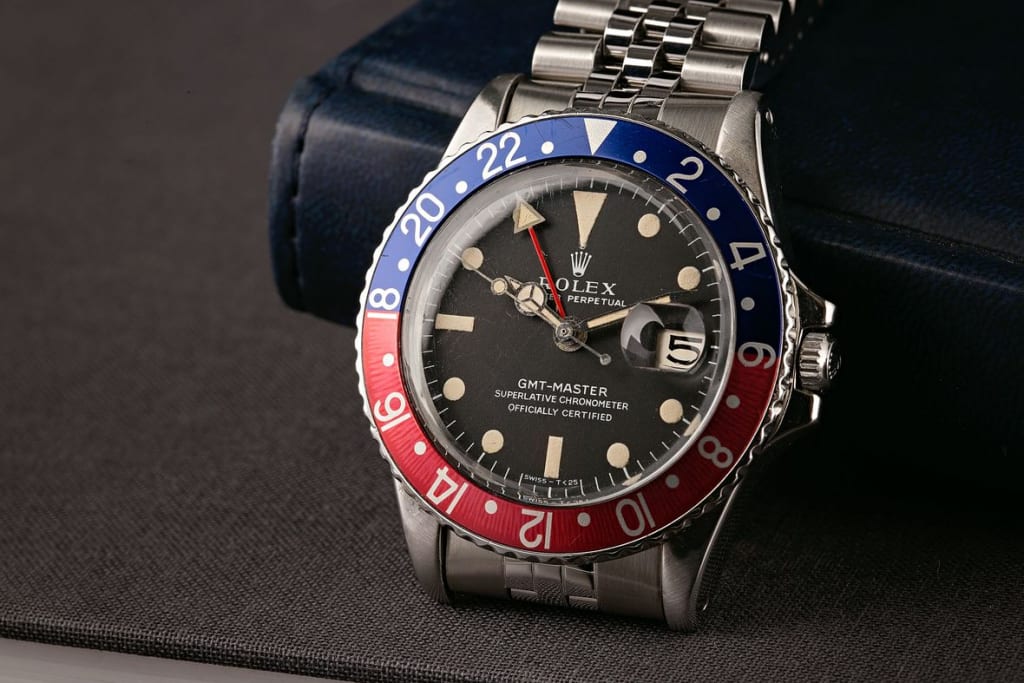
As we’ve explored throughout this comprehensive comparison, both the Rolex GMT-Master II and the Tudor Black Bay GMT stand as exceptional timepieces in the world of luxury watches. Each brings its own strengths to the table, catering to different preferences and needs in the realm of dual-time functionality.
The Rolex GMT-Master II continues to reign as the quintessential luxury GMT watch. Its combination of prestigious brand heritage, cutting-edge materials, and fine craftsmanship makes it a grail watch for many collectors and enthusiasts. The independently adjustable hour hand, Cerachrom bezel, and potential for value appreciation set it apart in the high-end watch market. For those who prioritize brand recognition, top-tier finishing, and are willing to invest in a potential heirloom piece, the Rolex GMT-Master II is hard to beat.
On the other hand, the Tudor Black Bay GMT offers a compelling alternative that brings much of the GMT functionality and robust build quality to a more accessible price point. Its vintage-inspired design, in-house movement, and versatile aesthetics make it an excellent choice for those entering the luxury watch market or seeking a more understated timepiece. The Tudor appeals to practical enthusiasts who appreciate fine watchmaking but may not want to invest in the premium commanded by Rolex.
At Bob's Watches, we understand that choosing between these two exceptional timepieces is a personal decision that goes beyond mere specifications. Whether you’re drawn to the iconic status of the Rolex GMT-Master II or the value proposition of the Tudor Black Bay GMT, we’re here to help you find the perfect watch to accompany you on your journeys. Our extensive collection of pre-owned luxury watches, including both Rolex and Tudor models, offers the opportunity to own these horological marvels at competitive prices. We invite you to explore both watch collections further, and our team of experts is always available to guide you in making the choice that best suits your style, needs, and budget.
With over two decades of experience in the luxury watch industry, the Bob's Watches Editorial Team stands at the forefront of watch expertise and insight. Our team, composed of seasoned watch enthusiasts, skilled horologists, and knowledgeable industry insiders, is dedicated to bringing you the latest and most accurate information in the world of luxury timepieces. We pride ourselves on our meticulous attention to detail and our unwavering commitment to authenticity. Our editorial content is a reflection of our passion for luxury watches and our dedication to providing our readers with comprehensive, unbiased, and up-to-date information. Our expertise spans a wide range of topics, including in-depth reviews of the latest models, historical retrospectives of iconic timepieces, and insightful analyses of market trends. We are also renowned for our detailed guides on watch maintenance and investment advice, making us a trusted resource for both seasoned collectors and new enthusiasts alike. As thought leaders in the watch industry, we understand the importance of staying ahead of the curve. That's why we continually update our knowledge and skills, ensuring that our readers receive the most current and relevant information. Whether you're seeking advice on your next luxury watch purchase or looking to deepen your understanding of watch craftsmanship, the Bob's Watches Editorial Team is here to guide you.